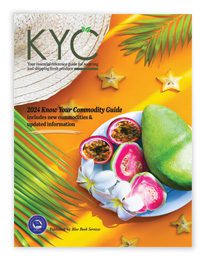Sapodilla Market Summary


Image: Regreto/Shutterstock.com
Sapodilla Market Overview
Native to southern Mexico, Central America, and the Caribbean, Manilkara zapota, or the sapodilla, is a relatively common tropical fruit that grows from a large, flowering evergreen type of tree. Taken to Southeast Asia by explorers centuries ago, it is as popular in Asia as Latin America. The fruit made its way to Florida from the Bahamas. Part of the Sapotaceae family and commonly called sapodilla in the United States, the fruit is a relative of the mamey sapote. It is known by many names around the world including buah chiku, chico, chiku or chikoo, dilly, lamud, lomut, naseberry, nispero, sapota or sapoti, zapote, and zapotillo. Although it can be dried for snacking or used in jams, syrups, muffins, pies, sherbet, or other desserts, sapodilla blends especially well into juices, syrups, smoothies, and fruit salads. The fruit is most often eaten fresh, at room temperature, or briefly chilled (which some believe improves flavor). Sapodilla trees are also grown for ornamental and landscaping purposes. Tree bark produces a gummy latex called chicle, which was used for many years as the principal ingredient in chewing gum.
Types & Varieties of Sapodillas
The outside skin of the sapodilla is brown, dull, textured, and flakey, while the inside is soft, juicy, and very sweet. Flesh ranges in color from yellow to brownish, depending on variety. Fruit is small, round or oval shaped, and about 2 to 4 inches in length. Elliptical, dark seeds generally reside inside the fruit, but should not be eaten as they have an unusual ‘hook’ shape that can stick in the throat. India is the largest commercial producer of sapodilla fruit with more than three dozen varieties, cultivated in two annual seasons. The bulk of production is consumed within the country, with a very small portion exported, mainly to the Middle East. The fruit is also grown in tropical and subtropical regions around the globe including Australia, Bangladesh, Indonesia, New Zealand, Malaysia, Pakistan, Palestine, the Philippines, South Africa, Sri Lanka, Thailand, Vietnam, and the West Indies. Sapodilla is not a common commercial crop in the United States, with the majority of production limited to South Florida. Most sapodilla available in the United States is imported. Varieties depend on growing region; in India, the main cultivar is called Kalipatti, along with Baramasi, Calcutta, Cricket Ball, Dhola Diwani, Dwarpudi, Oval, Pata, and others. Florida varieties include Alano, Betawi, Brown Sugar, Gonzalez, Martin, Modello, Molix, Ponderosa, Prolific, Russel, and Tikal.

Cultivation of Sapodillas
Sapodillas require a warm and humid climate for optimal growth. While mature trees, which can grow to heights of more than 50 feet, are hardy and can withstand freezing temperatures for short periods, young trees will likely suffer damage. Trees tolerate most soil types as long as they are well-drained and have ample sunlight. They can also withstand wind and salt spray, making them a good choice for coastal areas. Regular watering is necessary for younger trees, though mature trees can tolerate drier conditions and will not require watering except in periods of drought. Tree are planted from seeds, but often grafted or propagated through layering techniques, which produces shorter specimens with a rounder canopy of sturdy branches. Leaves are plentiful, clustered, and glossy green. Growth is slow and trees may take from 3 to 10 years to bear fruit. Flowers are off-white or cream-colored, bell-shaped, and can blossom all year. For the flowers that do develop into fruit, it can take 4 to 6 months to reach maturity. Once trees are comfortably in their bearing years, each can produce hundreds of fruit per growing cycle. It is important to harvest sapodilla fruit when fully mature, though it can be tricky to determine. Skin should be somewhat soft, wrinkle-free, and tan or brown, not green, and will not leak latex if scratched. Growers often harvest sapodilla after a few mature fruits have fallen from the tree. Sapodillas ripen within 4 to 10 days after picking if harvested at full maturity. Immature fruit will be overly sour or bitter and laced with latex, which lines the rough skin, and decreases during the ripening process. Ripe fruit has juicy flesh, similar in texture to pears or kiwis, with a flavor variously described as buttery, sugary, caramel-like, or malty like root beer. Sapodillas are rich in iron, antioxidants, fiber, vitamins A and C, and known for their anti-inflammatory properties.

